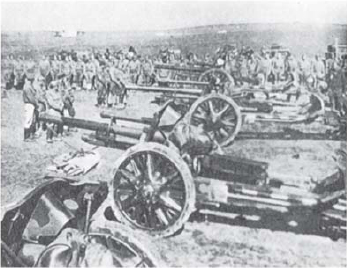
(Uniform research by Martin Windrow. Main sources, apart from photographs in published and unpublished collections, and surviving items of uniform and equipment in the Imperial War Museum, London, were: J. M. Bueno, Uniformes Militares de la Guerra Civil Española, San Martin, Madrid, 1971; articles by C. A. Norman in issues 66 and 67 of Tradition magazine; and an article on armoured vehicles by Stephen Zaloga in Model world magazine, now defunct.)
A1 Alférez, Tiradores de Ifni, campaign dress
The junior commissioned ranks in the Spanish Army were open to some long-serving native NCOs; hence this second lieutenant’s advanced years. His red tarbuch was regulation for native officers, and often worn on campaign by Spanish officers. It bears the branch badge of this class of Moroccan infantry—a five-point star in gold above a silver crescent—and the single six-point gold star of this rank below it. The rank is repeated on the left breast of the loose, ‘lentil’-coloured candora. Officers and men alike often wore this on campaign. It is worn here over a shirt and breeches of light sandy-coloured cloth, with brown leather equipment including the holster of the Astra automatic. The buckled leggings were regulation for native officers. (After Bueno.)
Spanish officers of the Tiradores de Ifni initially wore uniforms very similar to that of figure A2. The distinctive colour of the branch was initially red; the peaked cap had a red crown with gold piping, a green band, a brown leather peak and a gold chinstrap. The star-and-crescent badge appeared on the crown, and the rank stars on the band; the latter were repeated on a red strip above the left pocket, and the former was worn on each point of the collar. In 1937 the distinctive colour was changed to bright blue, which thereafter appeared on the crown of the cap and on the chest ranking; brown leatherwork was replaced by black at the same time.
A2 Capitán, Moroccan Regular Infantry, summer service dress
Officers of the Tropas Regulares de Marruecos wore this smart ‘lentil’-coloured uniform with a red-crowned cap piped gold (note vertical piping at sides) with a gold chinstrap and cloth-covered peak. Ranking appeared on a galleta (biscuit) on the left breast, in the colour of the unit: see caption A3 below. It was also worn in the usual Nationalist Army manner on the tunic sleeves. Alférez, teniente and capitán wore one, two and three six-pointed gold stars above the Polish cuff; comandante, teniente coronel and coronel wore one, two and three larger eight-pointed stars on the cuff itself. The branch badge of the Regulares, a numbered crescent in silver superimposed on crossed gold rifles, was worn on the cap crown. The Spanish officers of Moorish units wore a bright azure cloak lined white, which can be seen rolled on this officer’s cantle. Bueno shows many officers and occasional enlisted men of the Nationalist forces wearing Army Corps and, less frequently, divisional insignia on the upper left sleeve; that illustrated is the badge of the Cuerpo de Ejército Marroqui—a green shield with a red six-point Moroccan star above a white crescent; the gold letters C,E,M in top left, top right and bottom centre; and trimmed overall with gold. (Composite figure, after Bueno.)

German 10.5cm leFH.18 howitzers of the Legion Condor artillery element. Germany provided no significant numbers of combat personnel, but her aid to the Nationalists in the form of technical instructors and modern matériel was of incalculable value.
A3 Soldado, Grupo de Regulares de Ceuta no. 3, summer campaign dress
At the outbreak of the war the Moroccan regular troops comprised five grupos (roughly, regiments) each made up of several tabores (roughly, half-battalions) including an integral cavalry tabor. The soldiers wore sashes in distinctive colours, which were repeated in the rank ‘biscuits’ of the officers. These were: Tetuán no. 1 (red), Melilla no. 2 (blue), Ceuta no. 3 (green), Larache no. 4 (dark blue) and Alhucemas no. 5 (dark red). During the war five more grupos were raised, and the colour-coding system broke down. These later units were Xauen no. 6, Llano Amarillo no. 7, Rif no. 8, Arcila no. 9 and Bab-Tazza no. 10. The typical summer campaign dress was a pale shirt and baggy zaraguelles trousers, a small white turban, puttees and white canvas shoes—alpargatas—with hemp soles. Puttees could be khaki, blue or sandy yellow. The turban—rexa—was decorated for parades with cords of the grupo colour; on such occasions an elaborately decorated leather wallet—skara—took the place of the plain one used on campaign. Leather equipment was often of an outmoded pattern, but this soldier has regulation issue infantry equipment with a brass buckle-plate decorated with the infantry branch badge—crossed musket and sword with a bugle-horn superimposed. The rifle is the ‘1916 Short’ Mauser. Tied to the shoulder brace with a strip of rag is the most commonly used grenade of the war, the Lafitte bomb. Rising behind this soldier is the flag of the 2a Tabor, Grupo de Ceuta no. 3; from illustrations it seems to have been about three feet square, on an eight- or nine-foot pike. (Composite figure, after Bueno.)
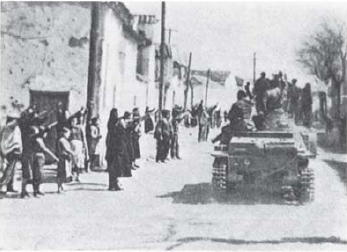
Civilians greeting Nationalist tank crews with the Fascist salute. The vehicles are German PzKpfw I tanks; it is impossible to tell whether they are crewed by Legion Condor or Nationalist personnel. The German instruction cadres handed the vehicles over to Spanish crews as soon as they were competent, and generally confined themselves to advisory and command duties in the latter part of the war. On the left rear plate of the nearest tank is the red-yellow-red Nationalist flash, and below its right hand end a tactical marking—apparently a circle divided horizontally, perhaps with red over white.
A4 Capitán of Republican infantry, service dress
The flat-crowned peaked cap and single-breasted service tunic of the Spanish Army were worn by officers of both sides, with differences of detail. The khaki cloth used by the Republicans tended towards brown, while that of the Nationalists was greener in tone. The Republicans wore the cap with a red star outlined gold on the crown, a branch badge in the centre of the band, and ranking in the form of horizontal bars on each side of this. Both sides used the traditional branch badges: gold bugle-horn and crossed musket and sword for infantry, silver crossed lances for cavalry, gold bursting grenade for artillery, silver castle for engineers, and so forth. Republican officers wore the tunic collar either buttoned closed or open over a khaki shirt and tie; in all cases the branch badge appeared on the collar points. Republican ranking was worn beneath the star on the sleeves: one, two and three thin bars above the cuff for second lieutenants, first lieutenants and captains, and one, two and three thick bars on the cuff itself for majors, lieutenant-colonels and colonels. There seems to have been some variation in details of cut, but the normal tunic had plain shoulder-straps, pleated patch breast pockets with three-point flaps, unpleated bellows skirt pockets with straight flaps, and brown leather buttons in an imitation ‘woven’ style. Flared khaki breeches were normal, though often replaced in practice by brown corduroy breeches. The high-lacing boots illustrated were very widely worn by Republican personnel. Sam Browne belts and Astra or Star automatics were normal in both armies. Note that a single button often appeared on the rear sleeve seam of the tunic just above the edge of the false Polish cuff. (After Norman.)
B1 Cabo, Nationalist infantry, service dress
This corporal wears absolutely regulation service dress in the greenish khaki of the Nationalist Army. His cap—known as a gorillo or ‘isabelino’—is piped in the infantry branch colour, red, and has a tassel of the same shade; a pointed rank device is worn on the front. Branch badges are worn on the collar of the guerrera, the thigh-length tunic; and the red ranking of this grade stretches from cuff to elbow. Sergeants wore the same device in gold. Buttons are brown, as is all leather equipment. The distinctive Spanish granadero trousers are flared at the thigh and tight at the calf, with buttons down the outside and a ‘spat’ foot. The haversack is in neutral-coloured canvas. The weapon is the ‘Short 1916’ Mauser. (After Bueno.)
The Falangist militias were territorially raised, and it was some months before their enthusiasm could be channelled into an orderly contribution to the Nationalist cause, under central control. This was reflected in their uniforms, which in 1936 varied widely. Common features were a black or dark blue gorillo cap piped white or red, a blue shirt, and the red yoke-and-arrows insignia of the Falange. In the early days they wore their own system of ranking; the breast badge of a jefe de centuria, for instance, approximating an Army teniente, was three silver arrows horizontally on a black patch, while a subjefe de bandera, the next rank up, wore a red yoke in the same position. In 1937 Army ranking was introduced, but for a time both could be seen in use together. One feature which remained constant was the red yoke-and-arrows breast badge, which was retained throughout the war. Our illustration, after Bueno, shows a Falangist in 1937 after a degree of rationalization had taken place. The blue cap is piped red; the blue shirt, highly visible, is now replaced by a khaki one, but blue collars, shoulder-straps and even pocket-flaps were often retained. The rest of the clothing and equipment is Army issue, though various puttee colours were worn according to availability. The white chevrons on cap and sleeve indicate a frontline combatant of the Falange, as opposed to other categories within the organization.
B3 Navarrese requeté, 1936
The requetés, the Carlist militia of the monarchist party, were even less uniformly dressed than the Falangists. A red beret was often the only common denominator in a mass of civilian items, but this beret was almost universal. This illustration of a requeté of the Navarrese brigades is taken directly from Bueno. He is surprisingly complete in his dress and equipment, wearing jacket and trousers of Army issue and regulation equipment. The short blouse or cazadora started to replace the guerrera tunic early in the war as campaign dress throughout the Army. It is worn here with the sleeve badge of the Cuerpo Ejército de Navarra. On the left breast are two other cloth insignia; the ‘detente’, or Sacred Heart emblem, which was widely worn by devout Catholics (particularly Carlists) in the hope of heavenly protection, and the Cross of Burgundy, emblem of the monarchist cause. The blanket and sandals are typical of the region.
In the background, an officer in shirt-sleeve order carries the colour of Regimiento de Infanteria ‘San Marcial’ no. 22; its design, and that of the elaborate red and gold bandolier, are taken from Bueno. The devices varied from unit to unit, but the red and gold tricolour ground was common to all Nationalist forces.
C1 Sargento porta-guión, 2a Bandera, Spanish Foreign Legion; summer campaign dress, 1936–37
Each bandera—roughly, battalion—of the Tercio had its own banner; in all, 18 banderas saw service during the war. That of the 2a Bandera, carried by this sergeant in typical summer campaign uniform, bears a black double-headed eagle crowned and taloned gold, with a central gold shield bearing the Legion’s badge: crossed musket, crossbow and halberd. The distinctive grey-green uniform of the Legion appeared in two weights for winter and summer: the hot weather dress comprised a shirt with rolled sleeves, the usual granadero trousers, and white canvas alpargatas. The cap was piped red, and differed from that of the rest of the Army in bearing the Legion’s branch badge on the front, so ranking was worn on the right side. The Legion badge was also worn in embroidered form on each shoulder-strap of the shirt, by all ranks. Leather equipment was always black, and often of an outmoded pattern.
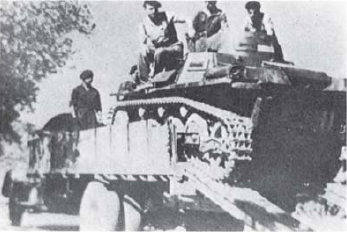
PzKpfw I Ausf.A tank being loaded onto a transporter lorry. The Nationalist flash, in tapered form, can be seen on the rear of the turret. Some of these tanks were finished in plain grey, others in grey with brown shadow camouflage. Local re-paint jobs were not unknown, usually taking the form of shadow camouflage.
Officers of the Tercio wore grey-green shirts with ranking on a black galleta and the Legion badge on the shoulder-straps; the gorillo bore the normal infantry ranking and piping. Grey-green breeches were worn with black jackboots, black Sam Brownes, and white gloves—often, even in battle. Gold chevrons trimmed red, as worn by this NCO, indicated wounds in action; they were worn on the left arm by all ranks. (Composite figure, after Bueno.)
C2 Legionario de 1a Clase, Spanish Foreign Legion, winter campaign dress 1938
Prior to 1938 the Tercio had worn guerrera tunics similar to those of the rest of the Army, but in that year the uniform illustrated was issued. A short cazadora was worn with straight trousers, tucked into high-lacing black boots. The colour remained grey-green and insignia were not affected. The large chevron of Private 1st Class was worn on both sleeves. (The cabo wore the three red diagonals illustrated on Plate B, and the sargento the same, in gold trimmed with red. The brigada, the senior NCO rank, wore a pointed gold device similar to that worn on the gorillo cap, but only divided by one vertical red line, sewn to the centre of the cuff at the bottom edge. These rankings were common to the Nationalist regular troops as a whole.) The rifle is the 7.92mm ‘Standard Model’ Mauser. (Composite figure, after Bueno.)
C3 Teniente, infantry, summer campaign dress
Nationalist officers wore a service dress very similar to that of the figure illustrated as A4, though in greener tones. The peaked cap bore the branch badge on the crown and the rank stars along the band. The tunic, normally worn buttoned to the throat, bore branch badges on the collar points, and ranking on the cuffs as described under figure A2. In the field a wide variety of jackets was worn in winter, and shirt-sleeve order was normal in summer. The gorillo of this infantry first lieutenant bears red and gold piping and tassel (these colours varied with branch colour and metal) and the two stars of this rank on the front. The light sandy-coloured shirt is worn with rolled sleeves and open neck, and the only insignia is the galleta in branch colour above the left pocket, with repeated rank stars. The Sam Browne was worn with either one crossed or two vertical braces, and in shirt-sleeve order was buttoned under the belt-loops of the flared greenish-khaki breeches. Brown jackboots; brown leggings and ankle-boots; and brown ankle-boots with khaki puttees, and sometimes white oversocks, seem to have been worn at whim. A popular if unofficial item was the sahariana jacket, copied from Italian officers of the CTV; the distinctive cut of this jacket can be seen more clearly on Plate E. It is thrown over this officer’s shoulders, and bears the galleta and the sleeve patch of the Cuerpo Ejército de Galicia. The weapon is the Star RU1935 gmm sub-machine gun; this saw limited service but was never standard issue. (Composite figure, after Bueno.)
Other branch colours worn as galletas and cap piping were: light blue (cavalry), with silver metal; dark red (engineers), with silver metal; red cap piping, and black-over-red galleta diagonally divided from bottom left to top right (artillery), with gold metal; yellow (medical), with silver metal; grass-green (light infantry—Cazadores), with gold metal; and black (tank troops), with silver metal. ‘Provisional’ ranks, and senior officers commanding units, wore black galletas irrespective of branch.
D1 General de Brigada, winter campaign dress
The field service gorillo of generals was piped with gold in a distinctive arrangement, as here, and had a gold tassel. On the front is the ranking—a crossed sword and baton with a four-point star superimposed. (The ranking of a general de división featured the crossed sword and baton between two smaller four-point stars, one on each side.) This is repeated on the black patch of a senior commander on the left breast of the cold-weather jacket. The jacket is one of several very similar patterns collectively known as the ‘canadiense’, much favoured by senior officers. The breeches of the normal service uniform are tucked into high-laced boots and thick socks. (Composite figure, after Bueno.)
D2 Cabo, Nationalist infantry, winter campaign dress
The capote-manta, a large, loose cape for winter campaign wear, was used very widely by both Republicans and Nationalists; it differed in a score of details from batch to batch, but the one illustrated is typical. The shoulders and neck have been doubled for extra protection, and a large vandyked flap allows the neck to be buttoned over the face from either side. Sometimes the cape was worn over, sometimes under the leather equipment; here the corporal has buckled his belt, shoulder-braces and haversack strap over it. (The leather shoulder-braces of the standard Spanish equipment met in a Y-strap arrangement on the back, with a single vertical brace down to the belt. A third ammunition box was worn centrally at the back.) Puttees and ankle-boots with white socks here replace the shaped overall-trousers. The helmet was by no means a universal issue, but it was seen in some numbers on both sides. Of Spanish design, it is based upon, but subtly different from, the traditional German design of World War I. It has a deep domed skull, a steeply-flared brim and neck-guard, and a noticeably shallow ‘step’ over the ears; there is one in the Imperial War Museum, London, that has a line of small rivets around the mid-point, see D3. It was usually painted a nondescript dark greenish grey. The rifle is the ‘Standard Model’ Mauser.
On the breast of the cape appear a stylized version of corporal’s ranking in infantry red, and the branch badge sewn onto a khaki patch. Branch badges were often seen in this position on protective clothing, either on khaki or patches of branch colour, and officers wore conventional rank ‘biscuits’ above them. (After Bueno.)
D3 Soldado, Nationalist infantry, winter campaign dress
The cazadora blouse bears the branch badge on the collar points, and is worn over a brown sweater. The granadero trousers, leather equipment, Mauser and helmet are all standard issue. It was normal for Spanish soldiers of both sides to make a horse-shoe roll of their blanket or cape. Note the large cloth-covered canteen worn on the hip, its base fastening into a metal pot and its neck covered by a metal cup, both painted dull green. A black strap round the body supports this canteen, which is copied from one in the Imperial War Museum. It is the only feature which we have added to this figure, which is otherwise exactly as in Bueno. Bueno shows a red crab motif painted on the helmet and sewn on the blouse, and identifies the soldier as a Galician volunteer. Whether the crab motif was common among men from this region is not known.
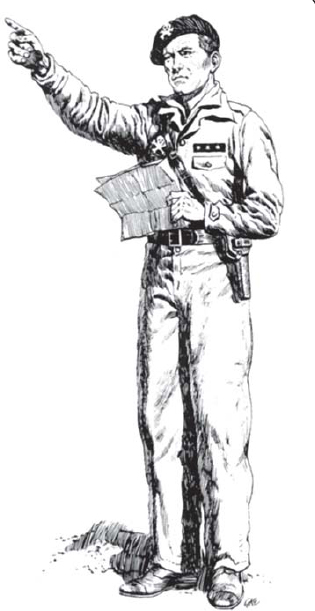
Capitán, Nationalist tank companies. Illustration by Embleton after Bueno. Black beret with white death’s-head; dark-brown overall with death’s-head repeated on right and silver rank stars on black ‘biscuit’ on left breast; brown belt and holster. For further comments on Nationalist tank uniforms, see description of colour plate E4.
E1 Staff captain, Division ‘Littorio’, Italian Volunteer Corps, 1937
The first Italian volunteers were from the MVSN—‘Blackshirt’—militias, and served in the Foreign Legion. As more arrived they formed their own units, or Banderas. By 1937 an autonomous corps was in existence: the Cuerpo de Tropas Voluntarias, CTV. It was made up of four weak divisions—actually, of brigade strength—and an autonomous combat group. The ‘Dio lo vuole’, ‘Fiamme Nere’, and ‘Penne Nere’ divisions and the group (later, division) ‘XXIII di Marzo’ were manned by Blackshirts, and the ‘Voluntarii Littorio’ divsion by Italian Army personnel. In 1938 the last two formations were amalgamated into a mixed MVSN-Army division named ‘Littorio d’Assalto’.
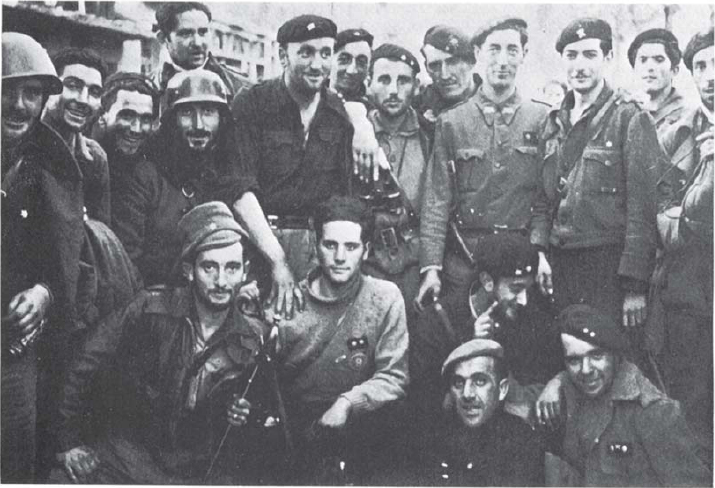
Group of Nationalist officers of the 5th Navarrese Division photographed after the capture of Tarragona early in 1939. Note the mixture of uniform items and insignia; the short cazadora jacket is worn by several of these officers, and branch badges can be seen on both the collars and the berets. Most wear berets, presumably the red Carlist type, with rank stars. In April 1937 the Falangist and J.O.N.S. militias were amalgamated by Franco, new units wearing the red beret and blue shirt in combination. These officers are identified as belonging to the ‘1a Bandera de F.E.T. y de las J.O.N.S. de Navarra’—the usual style of title for units of the new combined militia. The Alférez on the left wears a pasamontaña and a leather jacket. Note both Italian and German steel helmets in use. (Robert Hunt)
This figure is taken exactly from Bueno. The cap is the Italian bustina of officer quality and summer weight, with the three gold stars of this rank on the front flap. The jacket is the sahariana, which first became popular among Italian officers in Ethiopia, and spread to virtually every army which they fought with or against. The staff status is indicated by the white collar points edged gold. Rank stars appear on the left breast, and the divisional insignia on the left sleeve. The breeches and boots are normal Italian Army issue. Bueno illustrates a great diversity of Italian, Spanish, winter, and summer uniform items worn by Italian officers in various combinations. The Sam Browne supports the small Beretta holster.
E2 Volunteer, Division ‘XXIII di Marzo’, CTV, summer 1937
This private of the Blackshirt infantry volunteers is exactly as in Bueno. He wears what is effectively the Italian Army’s tropical uniform, with minor distinctions. The Italian M1933 helmet increasingly replaced the Adrian model worn at the beginning of Italian intervention. The shirt is peculiar to the CTV—a light grey-green pullover type with a zipped neck. The double black ‘flames’ and silver fasces of the MVSN appear on each collar point, and the divisional insignia on the left sleeve. Leather equipment, of the unique Italian design involving a loop of strap round the neck to support frontal belt pouches, is in grey-green, and the rifle is the 1891 Mannlicher Carcano.
E3 Leutnant, Legion Condor tank companies, in vehicle overalls
Bueno illustrates this rather exotic outfit, of mixed German/Spanish origin. The dark blue gorillo cap is piped in Spanish fashion in German Panzer pink branch colour, with gold rank stars but no tassel. The mono or overall has the ranking repeated on a pink ‘biscuit’ on the left breast, and is worn with German light khaki shirt, black marching boots, and brown field service belt.
E4 Alférez, Spanish Foreign Legion tank companies, 1938–39
The tank commander, who is taken from a similar figure by Bueno, wears a black beret with single gold rank star; a cazadora blouse in the Tercio’s greygreen, with rank star on a black galleta; and black leather equipment. Bueno shows a full-length figure wearing these with flared grey-green breeches and high-lacing black boots with buckled gaiter-flaps at the top, high on the calf. The Spanish tank troops’ badge seems to have been worn on the right breast by some tank officers of both sides. It was a silhouette of a stylised Renault tank, facing left; an example on a Republican officer’s shirt in the Imperial War Museum is embroidered in gold and black thread on a pale khaki ground, but Bueno states that Nationalist personnel wore the device in silver metal. An unofficial variation was apparently worn by some Legion and other Nationalist tank officers and NCOs, on the beret and/or on the right breast: a skull and crossbones badge in silver or white. Nationalist Army tank companies seem to have displayed great variety in vehicle uniforms. Mono overalls appeared in dark blue, light khaki or dark brown: the black beret was common, and the black galleta was standard.
The tank itself is taken from a photograph. It is a German Panzerkampfwagen I Ausf.A, finished in the dark Panzer grey and earth brown shadow camouflage employed in the German Army for a time during the mid-1930s. The white ‘513’ is a vehicle number; the red and yellow tricolour flash, carried on the front plate and on the turret rear, is the Nationalist recognition marking. The halved red and white diamond is a tactical marking of some kind; halved circles were also recorded. The white insignia next to the driver’s hatch is the badge of the Tercio tank companies, the familiar crossed musket, crossbow and halberd.
E5 Unteroffizier, Legion Condor tank companies
This figure is taken partly from Bueno and partly from a photograph. The service uniform of the Legion Condor was this khaki tunic and trousers, light khaki shirt, and black leather equipment. The tank companies wore a black Spanish beret. Officially the ranking was repeated on this, in the form of vertical gold bars on a Panzer pink backing, exactly like the horizontal presentation on the breast. Photos show silver metal beret badges—the Panzer skull and crossbones over a silver swastika. Officers’ ranking was worn on the tunic either as individual stars with branch-colour backing, or on a galleta of branch colour in the Nationalist manner; stars appeared individually on the headgear.
F1 Anarchist militiaman, 1936
The popular militias which rose spontaneously at the outbreak of the war owed their inspiration to numerous political and trade union organisations. Their clothing was civilian and their arms and equipment were whatever they could lay their hands on. The almost universal garment was the mono, the dungaree overall which became the trademark of the workers in arms. It appeared in numerous varieties of cut and colour, but dark blue was predominant. This anarchist wears the halved black and red scarf of the FAI—Federación Anarquista Ibérica. He has acquired a set of infantry equipment and a ‘Short 1916’ Mauser rifle. (Composite figure, after Bueno.)
F2 Cabo, Guardias de Asalto, 1937
Large numbers of security police sided with the Republic, and played an active role during the early periods of confusion when they were one of the few sources of trained and armed men. They also played an important part in the internal fighting against the anarchists in Barcelona. Probably because of the ambivalent feelings of many pro-Republican groups about uniformed security policemen, the Asaltos seem to have abandoned their dark blue service dress early on, and to have adopted the light blue-grey mono illustrated. A figure by Bueno, which we follow closely here, retains his dark blue peaked cap with the silver badge of the corps—a mural crown above an ornate escutcheon charged ‘GS’—with white piping, black peak and strap, and the red chevron of corporal’s rank, which is repeated on the breast. He wears the outmoded leather equipment often seen among troops from Morocco, and carries a ‘Short 1916’ Mauser.
F3 Miliciana, 1936
Women fought alongside men in the popular militias, and our figure represents one of the hundreds of Madrid factory-girls who took their places at the barricades. She wears the ubiquitous mono, adorned with roughly-stitched initials indicating her particular affiliation: UHP, UGT, CNT, PCE, POUM and FAI were all frequentlyseen variations, on home-made insignia and in wall-slogans. The espadrilles are typical. The cap is an Army gorillo modified in a common way: the red piping and tassel are removed, the points pushed inwards and sewn across to give a rounder top line, and a red star is roughly stitched to the front. Her weapon and equipment are of cavalry origin: the 1895 carbine, and the belt with single front pouch and silver buckle-plate were standard issue to that branch.
G1 General Miaja, service dress
Uniformity was even less common in the Republican Army than in the Nationalist, but this figure, after Norman, shows Miaja in normal service uniform for a general. Minor details such as pockets, the use of breeches or trousers, and so forth, naturally varied. The khaki cap bears the red star above the special generals’ cap badge in gold—a crowned escutcheon flanked by scrolled pillars. The peak bore gold braid of varying widths for field officers and generals. The tunic collar bears the generals’ crossed baton and sword. On the sleeves above the cuff are two types of ranking. From October 1936 to February 1937, and after October 1938, all grades of general in the Republican Army were amalgamated into a single rank—general. The insignia was as shown: three red stars around the crossed baton and sword. The actual level of command was indicated by the three-pointed stars below this; in this case, the four of an army commander. This separation of rank and function stemmed from the irregular militia backgrounds of some senior commanders; non-regular officers were not allowed to rise above lieutenant-colonel in rank, but some natural talents of this rank in fact commanded divisions and corps. One three-point star indicated command of a brigade, two a division, three a corps and four an army.
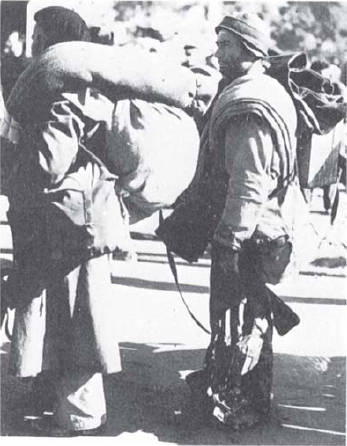
February 1939—footsore and burdened with salvaged kit, Republican soldiers reach the border town of Le Perthus in their retreat from the victorious Nationalists. (Keystone)
G2 Teniente Coronel Vladimir Čopic, commanding XVth International Brigade
This figure, after Norman and various photographs, is typical of the campaign dress of Republican officers. The khaki peaked cap has the narrow gold peak braid of a field officer; the Republic’s red star trimmed gold; and the infantry branch badge flanked by the two thick horizontal stripes of his rank. Various privately acquired leather jackets and coats were much in evidence, and on every type of coat, jacket and blouse apart from the service dress tunic the ranking was worn on a breast patch, usually of khaki cloth. The red star appeared on this above the ranking, and below these, where appropriate, three-pointed ‘command stars’ here, the single star of a brigade commander. Choice and arrangement of such accessories as boots, belts and sidearms was a matter for the individual in the Republican Army. Political commissars wore a red star in a red circle above horizontal red bars indicating grade (one for company commissar, two for battalion commissar, etc.) on cap and breast.
G3 Cabo, infantry, service dress
A composite figure based on the differing interpretations by Norman and Bueno of a surviving colour plate believed to show the official uniform authorized in October 1936. To what extent this was actually issued is unclear; parts were observed, but it is unlikely that the whole outfit was supplied in significant numbers. The cap is a khaki cloth version of the pasamontaña, which was a popular Republican headgear. Its classic version was a wool balaclava with a peak, which could be worn rolled into a sort of peaked cap-comforter of the outline illustrated here. Bueno shows it in its cloth form with a rank chevron, a branch badge, and a brown chinstrap; Norman shows it without badge or strap. The tunic is shown here exactly after Norman; Bueno shows no skirt pockets, and with the buttoned cuff tab at the bottom edge of the sleeve. Both show the laced and buckled boots with ankle-flaps, and the straight trousers. Standard belt and pouches are worn with an infantry buckle-plate, but in this case without the shoulder-braces. The weapon is the ‘Mexicanski’, the most common rifle among many different types acquired by the Republic; it is a Russian Moisin-Nagant supplied via Mexico. Note the archaic socket bayonet, worn fixed at all times but sometimes reversed.
In the background is the Russian T-26 tank, most numerous of the types used by the Republic, and most effective on either side; the Nationalists offered large bounties for captured ones, and formed whole companies of them. The colour scheme is from a photo: basic Soviet forest-green with a drab brown streak-pattern over the upper hull and turret, the streaks edged with an indeterminate light shade. Turret markings in the Republican tank companies were restrained, seldom going beyond a simple number. The commander wears the typical nondescript clothing of most Republican personnel. His shirt, with tank badge on the right breast (see under E4) and rank patch on the left, is taken from one in the Imperial War Museum. A khaki beret was very widely worn in the Republican Army, and not infrequently in the Nationalist forces as well.
H1 Infantryman, winter campaign dress
A composite figure assembled from many typical features, after Norman and Bueno. One can only generalize when discussing Republican combat troops, whose equipment came from many different Spanish and overseas sources, and who never achieved any real uniformity of clothing.
The headgear is the woollen pasamontaña, pulled down to protect the face. The khaki greatcoat was much more common on the Republican than the Nationalist side, which seems to have favoured the capote-manta. Republican stocks came from many sources, and many were of French origin. In the absence of coats, rough ponchos or capote-mantas were made from blankets or canvas. Khaki trousers or corduroys were worn either loose, or with puttees, with ankle- or high-laced boots, or even with sandals. Rolled blankets of civilian origin were common. Standard infantry equipment is worn here, with two noteworthy additions. The tin plate slung from the belt was very common in the Republic, and served as a mess-tin. The grey or khaki Adrian helmet was imported from France in large numbers at the beginning of the war and was by far the most common helmet used by the Republic—although helmets were by no means a universal issue at all. Some Spanish helmets were used towards the end, but most seem to have been captured from Nationalist stocks. Sometimes a red star was painted on the front.
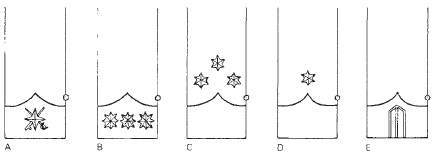
Nationalist ranking on tunic cuffs.
(A) General de Brigada
(B) Coronel
(C) Capitán
(D) Alférez
(E) Brigada —gold, trimmed red.
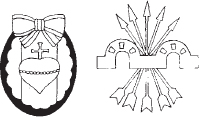
Left: the ‘detente’ or Sacred Heart emblem; details varied but this presentation is typical. Black backing, red and yellow riband, red patch with scalloped edges, yellow vertical centre stripe, red heart and cross with details trimmed black. Right: the red yoke-and-arrows device of the Falange Española.
H2 Brigada, infantry, campaign dress
The khaki beret was widely worn; here it bears a typical rank patch, with the two red bars below a red star of the senior NCO rank. (The cabo wore the chevron shown in G3, the sargento a red star above a single red bar.) This is repeated on a chest patch on the khaki cazadora, which in various slightly differing forms was the commonest type of jacket in the Republican Army; it appeared in cloth of many shades, in leather, with zips and plastic or leather buttons, with or without branch insignia on the collar, and in various civilian materials and patterns. Trousers were as heterogeneous; cloth of khaki or brown shades, flared or straight in cut, of corduroy, of light striped ticking—all were to be seen in the ranks. The high-laced boots were common, as stated earlier. Shirts and sweaters of every colour and type were worn indiscriminately. Many old French Army uniforms were acquired and worn complete or in part. The mono never entirely disappeared, and was worn in various light grey, green and khaki shades. A floppy khaki cotton sun-hat of army origin was seen on both sides during summer fighting. The oval metal canteen carried on this NCO’s belt was sometimes, but not often observed covered in khaki felt. The weapon is interesting; never a regular issue, it was occasionally seen in the hands of junior leaders or security forces. It is the Astra Model 902, a 7.63mm selective-fire copy of the 1932 Mauser ‘broomhandle’ pistol, with a wooden holster-stock. The fixed magazine required an extra cut-out in the rear face of the holster-stock, covered with a leather stall. (Composite figure, after Norman.)
H3 Capitán, Ejército Nacionalista Vasco, campaign dress
The ‘gudaris’ or Basque soldiers who supported the Republic served in their own autonomous units; they were an important source of spirited manpower, numbering some 25,000 in November 1936. Uniforms were minimal, but the common feature was the black Basque beret. Ranking generally followed Nationalist Army practice, with officers’ stars worn, as here, on beret and breast, and NCO’s distinctions similar to the pointed patches worn by Nationalists. The leather jacket was very common among Basque officers. Trousers of white and grey or blue ticking were apparently much in evidence in Basque units. (After Bueno.)
H4 Soldado, Grupo de Regulares de Alhucemas no. 5, winter campaign dress
In winter the Moorish troops of the Nationalist Army were usually issued a cazadora in greenish khaki. The baggy sand-coloured trousers, khaki puttees and white canvas boots seem to have been retained, according to Bueno. Overgarments varied, but the chilaba or native cape-coat was not uncommon. Bueno shows some Moors retaining the tarbuch, others in woollen pasamontañas. This figure is from Bueno; note the red cord decoration on the loose, hooded chilaba. This cording extended round the edge of the hood, down the front, down the outside of the loose sleeves, and round the edges of the split at elbow level which allowed free movement. It also edged the patch bearing the unit number and crescent in white.
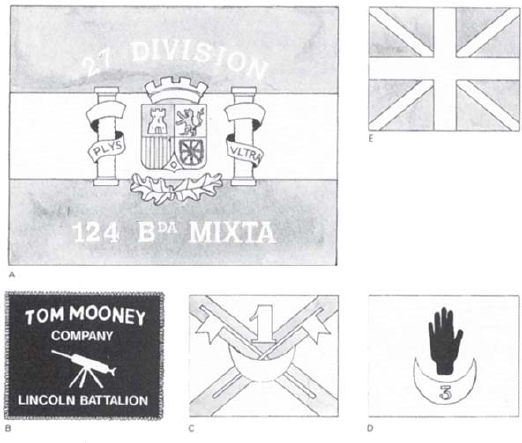
Examples of flags and guidons carried during the war. (A) Typical standard of a Republican brigade, the 124th Mixed Brigade of the 27th Division. Red over yellow over purple stripes. White lettering. Central motif: white columns with white ribands bearing black ‘PLUS ULTRA’, gold capitals and bases, gold crown with red interior, green foliate sprays. First quarter of shield red with gold tower, second white with red lion, third red with gold ‘chained’ shield device, fourth yellow with red stripes; small pointed area at bottom centre, white. (B) Flag of machine-gun company of American ‘Lincoln’ Battalion, XVth International Brigade: yellow on dark blue, yellow fringe. (C) Guidon of a tabor of Moroccan regular cavalry: light blue with red saltire, white number, white crescent and lances. (D) Standard of a tabor of Moroccan regular infantry: yellow, black hand, white crescent, number outlined black. (E) Flag of the Euzkadi—the Basque Republican units: red, white cross, green saltire.